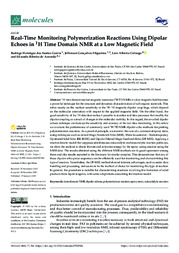Real-Time monitoring polymerization reactions using dipolar echoes in 1H time domain NMR at a low magnetic field.
Real-Time monitoring polymerization reactions using dipolar echoes in 1H time domain NMR at a low magnetic field.
Autoria: GARCIA, R. H. S.; FILGUEIRAS, J. G.; COLNAGO, L. A.; AZEVEDO, E. R.
Resumo: 1H time domain nuclear magnetic resonance (1H TD-NMR) at a low magnetic field becomes a powerful technique for the structure and dynamics characterization of soft organic materials. This relies mostly on the method sensitivity to the 1H-1H magnetic dipolar couplings, which depend on the molecular orientation with respect to the applied magnetic field. On the other hand, the good sensitivity of the 1H detection makes it possible to monitor real time processes that modify the dipolar coupling as a result of changes in the molecular mobility. In this regard, the so-called dipolar echoes technique can increase the sensitivity and accuracy of the real-time monitoring. In this article we evaluate the performance of commonly used 1H TD-NMR dipolar echo methods for probing polymerization reactions. As a proof of principle, we monitor the cure of a commercial epoxy resin,using techniques such as mixed-Magic Sandwich Echo (MSE), Rhim Kessemeier—Radiofrequency Optimized Solid Echo (RK-ROSE) and Dipolar Filtered Magic Sandwich Echo (DF-MSE). Applying a reaction kinetic model that supposes simultaneous autocatalytic and noncatalytic reaction pathways,we show the analysis to obtain the rate and activation energy for the epoxy curing reaction using the NMR data. The results obtained using the different NMR methods are in good agreement among them and also results reported in the literature for similar samples. This demonstrates that any of these dipolar echo pulse sequences can be efficiently used for monitoring and characterizing this type of reaction. Nonetheless, the DF-MSE method showed intrinsic advantages, such as easier data handling and processing, and seems to be the method of choice for monitoring this type of reaction.In general, the procedure is suitable for characterizing reactions involving the formation of solidproducts from liquid reagents, with some adaptations concerning the reaction model.
Ano de publicação: 2022
Tipo de publicação: Artigo de periódico
Unidade: Embrapa Instrumentação
Palavras-chave: Autocatalytic reaction, Dipolar echoes, Epoxy resin, Ime-domain NMR, Polymerization reaction
Observações
1 - Por padrão são exibidas publicações dos últimos 20 anos. Para encontrar publicações mais antigas, configure o filtro ano de publicação, colocando o ano a partir do qual você deseja encontrar publicações. O filtro está na coluna da esquerda na busca acima.
2 - Para ler algumas publicações da Embrapa (apenas as que estão em formato ePub), é necessário ter, no celular ou computador, um desses softwares gratuitos. Sistemas Android: Google Play Livros; IOS: iBooks; Windows e Linux: software Calibre.
Acesse outras publicações
Acesse a Base de Dados da Pesquisa Agropecuária (BDPA) para consultar o acervo completo das bibliotecas da Embrapa.

